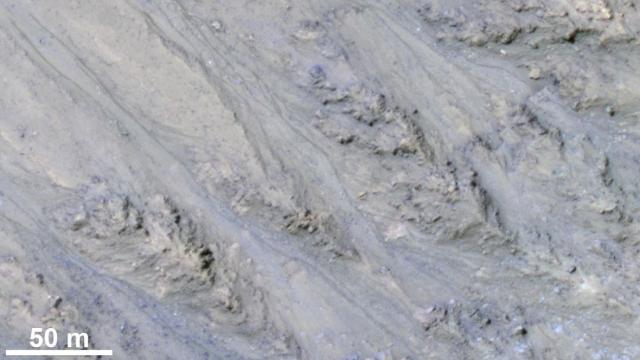Facts are built into the fabric of the universe, but science can sometimes be a problematic tool for establishing them. On occasion, even the most exciting discoveries can be overturned with more evidence.
Image: NASA/JPL/University of Arizona/USGS
Take the flowing water on Mars. Two years ago, NASA made a baffling announcement based on the appearance of seasonal flows, called “recurrent slope lineae” (RSL). Obviously everyone’s first thought was life. But a new study seems to have cast doubt on whether water was truly the cause of these features. Maybe it was sand all along.
“Flowing liquid water in the current Martian climate has always been an extraordinary claim,” the authors write in the study, published in the journal Nature Geoscience yesterday. “The observations and interpretations presented here suggest that RSL are no longer extraordinary evidence.”
Scientists established the original evidence for water on Mars based on temperature-dependent darkening of the narrow, streaky RSL. Data from the Mars Reconnaissance Orbiter implied that the darkening was caused by water flowing and hydrating the salts, according to a paper also published in Nature Geoscience.
The new study from a team of researchers in the United States and the United Kingdom took a look at the Martian topology. It found that the specifics of these darkened RSL, especially their length based compared to the slope of the hill, would be better explained by flowing grains of sand. More water would flow further down a slope – something not observed.
The study doesn’t rule out water completely – there’s definitely evidence for some at the poles. Tanya Harrison, Director of Research for Arizona State University’s Space Technology and Science (“NewSpace“) Initiative, told Gizmodo she felt there were still some things a dry flow like this couldn’t explain – seasonality, for example. “As the paper states, these observations point toward volatiles (i.e., water) being involved in some fashion. Even if it’s a minuscule amount of liquid water, that’s still a big deal for Mars.”
But it casts doubt on just how much flowing water there is and on the potential presence of life. “Liquid water involved is likely to be low volume with low activity, inhospitable to known terrestrial life, alleviating planetary protection concerns,” the paper continues.
There’s still work to do in order to understand the RSL. “Full understanding of RSL is likely to depend upon on-site investigation of these features,” said Mars Reconnaissance Orbiter Project Scientist Rich Zurek, not involved in the study, in a NASA JPL statement. “In particular, a full explanation of how these enigmatic features darken and fade still eludes us. Remote sensing at different times of day could provide important clues.”
And if a humans do visit, planetary protection concerns will remain until the site is fully understood “to guard against introducing microbes from Earth,” said Zurek, “at least until they are definitively characterised.”
